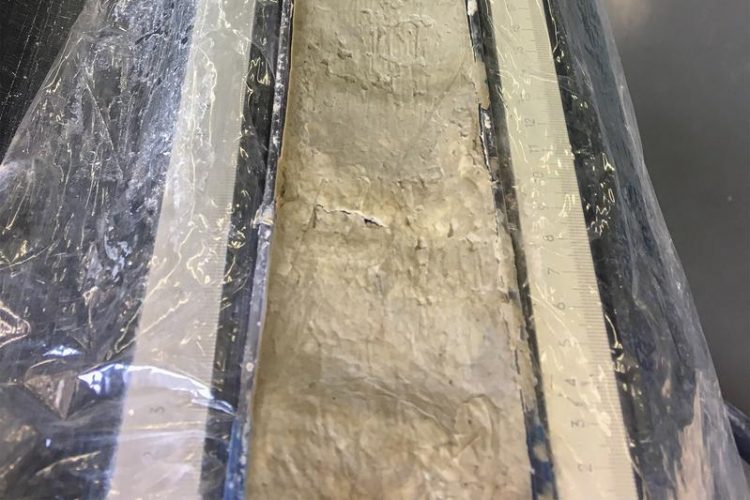Diatom ooze sediments are a large marine mercury sink

Marine bottom sediments which consist mainly of diatom remains (diatom ooze). Sara Zaferani/TU Braunschweig
Atmospheric derived mercury is transformed in the ocean to toxic methylmercury, which is enriched in fish. Large marine predators such as tuna are strongly affected and even humans through fish consumption.
Up to now, no data on mercury accumulation in deep sea sediments has been available. Scientists from TU Braunschweig have now investigated the role of microalgae for mercury accumulation in biogenic marine sediments.
The environmental geochemistry group at the Institute of Geoecology at TU Braunschweig under direction of Prof Harald Biester has investigated marine bottom sediments which consist mainly of diatom remains (diatom ooze) for the historical accumulation of mercury.
Those so called diatom ooze sediments are a result of algae blooms in the nutrient rich water of the Southern Ocean and form sediments of more than 100 m thickness with sedimentation rates of more than 1 cm per year.
With their analyses the scientists can show for the first time that diatom ooze accumulates large amounts of mercury in deep ocean sediments. Mercury accumulation rates derived from sediment cores from marine Antarctica are the highest ever reported for the marine environment.
Calculations based on the silicon/mercury ratio in the investigated sediment cores as well as literature data on global diatom ooze sedimentation reveal that between 9 and 20 percent of the annually emitted mercury from industrial sources could have been buried by diatoms alone. Moreover, diatom ooze could have been accumulated between 6,5 and 20 percent of all mercury emitted to the atmosphere during the industrial period. These results highlight the important role of algae for the accumulation of mercury in marine sediments.
The high resolution (10-40 years) historical mercury record (8.600 years) derived from Adélie Basin (marine Antarctica) sediments indicates that anthropogenic mercury pollution in Antarctica started with the beginning of the industrial period at around 1850 AD.
Earlier emissions, for example from colonial gold and silver mining in the 16th century where mercury was used for the extraction of the precious metals, could not be detected. Overall, the publication presents new important results for the global distribution of mercury emitted from anthropogenic sources and its enrichment in the marine food chain.
Prof. Harald Biester
Leiter der Arbeitsgruppe Umweltgeochemie
Technische Universität Braunschweig
Institut für Geoökologie (IGÖ)
Langer Kamp 19c
38106 Braunschweig
Tel.: +49 (0) 531 391-7240
E-Mail: h.biester@tu-braunschweig.de
Web: https://www.tu-braunschweig.de/geooekologie/institut/geochemie
Zaferani S, Pérez-Rodríguez M, Biester H (2018) Diatom ooze—A large marine mercury sink, Published Online 26 Jul 2018, DOI: https://doi.org/10.1126/science.aat2735
Media Contact
All latest news from the category: Earth Sciences
Earth Sciences (also referred to as Geosciences), which deals with basic issues surrounding our planet, plays a vital role in the area of energy and raw materials supply.
Earth Sciences comprises subjects such as geology, geography, geological informatics, paleontology, mineralogy, petrography, crystallography, geophysics, geodesy, glaciology, cartography, photogrammetry, meteorology and seismology, early-warning systems, earthquake research and polar research.
Newest articles

NASA: Mystery of life’s handedness deepens
The mystery of why life uses molecules with specific orientations has deepened with a NASA-funded discovery that RNA — a key molecule thought to have potentially held the instructions for…

What are the effects of historic lithium mining on water quality?
Study reveals low levels of common contaminants but high levels of other elements in waters associated with an abandoned lithium mine. Lithium ore and mining waste from a historic lithium…

Quantum-inspired design boosts efficiency of heat-to-electricity conversion
Rice engineers take unconventional route to improving thermophotovoltaic systems. Researchers at Rice University have found a new way to improve a key element of thermophotovoltaic (TPV) systems, which convert heat…



